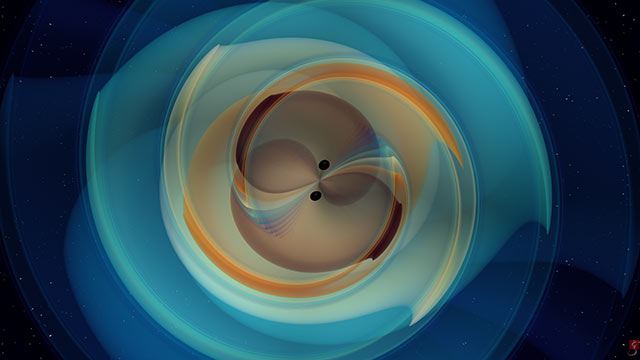Northwestern astronomers detect massive black hole as part of international collaboration
Credit: N. Fischer, H. Pfeiffer, A. Buonanno, and the SXS Collaboration
A group of Northwestern astronomers are among a team of researchers who recently discovered the most massive binary black hole merge.
October 5, 2020
An international team of researchers including a group of Northwestern astronomers recently detected the first ever “intermediate-mass” black hole.
The researchers are all a part of the National Science Foundation’s Laser Interferometer Gravitational-wave Observatory (LIGO) Scientific Collaboration. They found that two black holes likely collided, forming the most massive binary black hole merger yet observed in gravitational waves.
Black holes traditionally form when a star collapses in on itself, but the team found that this hole was so massive, it had to have been formed from two other black holes merging. The resulting black hole has a final mass 142 times that of the sun, or 142 solar masses — putting it in an intermediate-mass range between stellar-mass and supermassive black holes.
One of the black holes in the binary black hole merger has a mass of 85 solar masses. Astronomy Ph.D. candidate Chase Kimball said it falls within the mass range for a pair-instability supernova, which ultimately results in a loss of pressure and the supernova tearing the star apart, which wouldn’t result in a black hole.
“It’s really a mystery as to how this black hole formed,” Kimball said. “So one thing that we talked about is, could this black hole have not formed from a star, but rather it formed from two other black holes merging?”
The researchers determined that the signal traveled across space for 7 billion years before reaching Earth, making it the most distant gravitational-wave source detected so far.
LIGO Scientific Collaboration member Eve Chase said the team detects gravitational waves using a computer program, and they have to search through “very messy and noisy” data to find them.
“Gravitational waves are relatively weak signals, so we’re looking for changes in distances at the LIGO detectors smaller than the width of an atom,” Chase said.
Chase added there is work going into speeding up the analysis of data and backtracking the history of the masses detected.
Center for Interdisciplinary Exploration and Research in Astrophysics Board of Visitors Research Prof. Christopher Berry said it is very exciting to be in the field of gravitational wave astronomy right now because of the number of discoveries being made recently, which in turn allow the researchers to gain insights on these stellar mass objects.
“We’ve been doing gravitational wave astronomy for five years,” Berry said. “And what is particularly exciting about gravitational wave astronomy and being in this field right now is that we are making so many discoveries. We’re detecting lots of gravitational wave signals coming from lots of binaries.”
He added that he is glad to be at NU during this “explosion” in the field of gravitational wave astronomy.
“It’s great to be at Northwestern because we have expertise both in understanding the gravitational wave observations and making predictions for what these sorts of properties are, so Northwestern is a real leader here.”
Email: vivianxia2023@u.northwestern.edu
Twitter: @vivianxia7
Related Stories:
— Northwestern astrophysicists reflect on discovery of neutron star collision
— Four NU astronomers among the first to detect neutron star collision
— Northwestern researchers part of historic gravitational waves discovery


